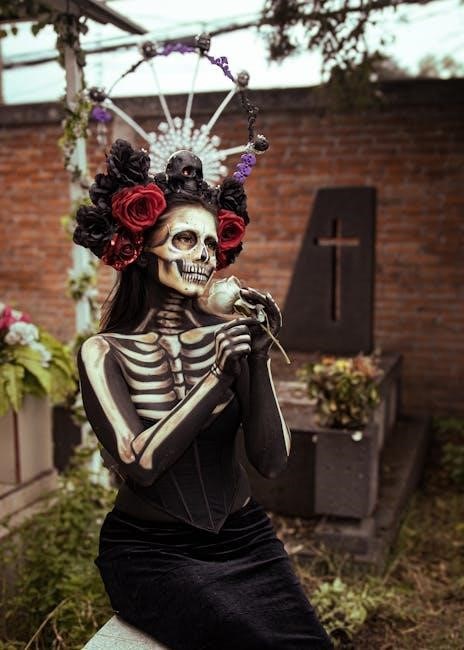Cemetery symbols are a visual language conveying emotions, beliefs, and memories. They adorn gravestones, telling stories of lives, faith, and afterlife, offering comfort to mourners.
Overview of Cemetery Symbolism
Cemetery symbolism encompasses a wide range of motifs that convey beliefs, emotions, and memories. These symbols, often carved on gravestones, reflect themes of death, afterlife, hope, and eternal life. They include religious icons like crosses and doves, natural elements such as trees and flowers, and animals like birds and lambs. Each symbol carries specific meanings, from mortality and resurrection to love and faith, offering solace to mourners while honoring the deceased. Their designs vary across cultures and eras, yet they universally bridge the living and the departed.
Importance of Understanding Cemetery Symbols
Understanding cemetery symbols bridges the past and present, offering insights into the beliefs, emotions, and lives of those who have passed. These symbols, often deeply personal, provide comfort to mourners while preserving history. They reveal cultural, religious, and social values, allowing us to connect with ancestors and honor their memories. By deciphering these motifs, we uncover stories, traditions, and the enduring human spirit, fostering a deeper appreciation for heritage and the universal experience of loss and remembrance.
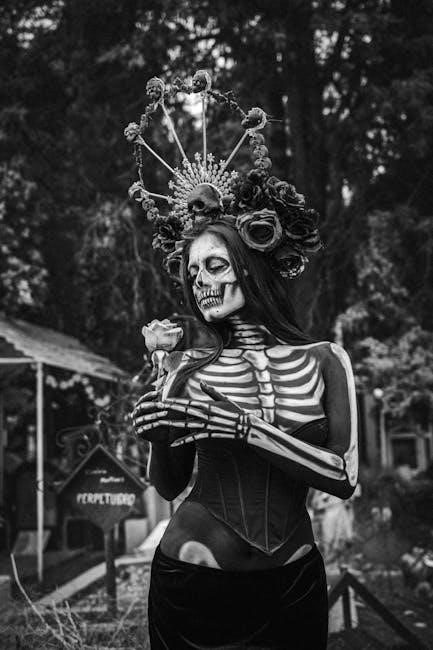
Symbols of Death and Mortality
Symbols of death and mortality, like skulls and hourglasses, remind us of life’s transient nature and the inevitability of human destiny, reflecting solemn contemplation.
Winged Skull: Ascension into Heaven
The winged skull symbolizes the soul’s ascension to heaven, blending death with spiritual transcendence. Often found in colonial American grave markers, it represents the journey from mortality to eternal life. The wings signify flight and liberation, while the skull embodies death, creating a powerful contrast. This motif reflects hope and belief in an afterlife, offering comfort to mourners by celebrating the deceased’s eternal journey rather than mourning their loss alone.
Hourglass: Reminder of Mortal Life
The hourglass is a poignant symbol of mortality, reminding us that time is fleeting and life is short. Often depicted with sand flowing from top to bottom, it signifies the irreversible passage of time. In cemetery symbolism, it urges the living to reflect on their own mortality and cherish the time they have. This motif was commonly used in colonial-era cemeteries to emphasize the transient nature of human existence and the inevitability of death.
Skull and Crossbones: Death and Mortal Remains
The skull and crossbones is a stark symbol of death and mortality, often used to signify the inevitability of human demise. Commonly found in colonial and early American cemeteries, it serves as a grim reminder of life’s transience. The crossbones, paired with the skull, emphasize the finality of death and the physical remains left behind. This motif was frequently used to convey the universal truth of mortality, urging the living to prepare for their own end.
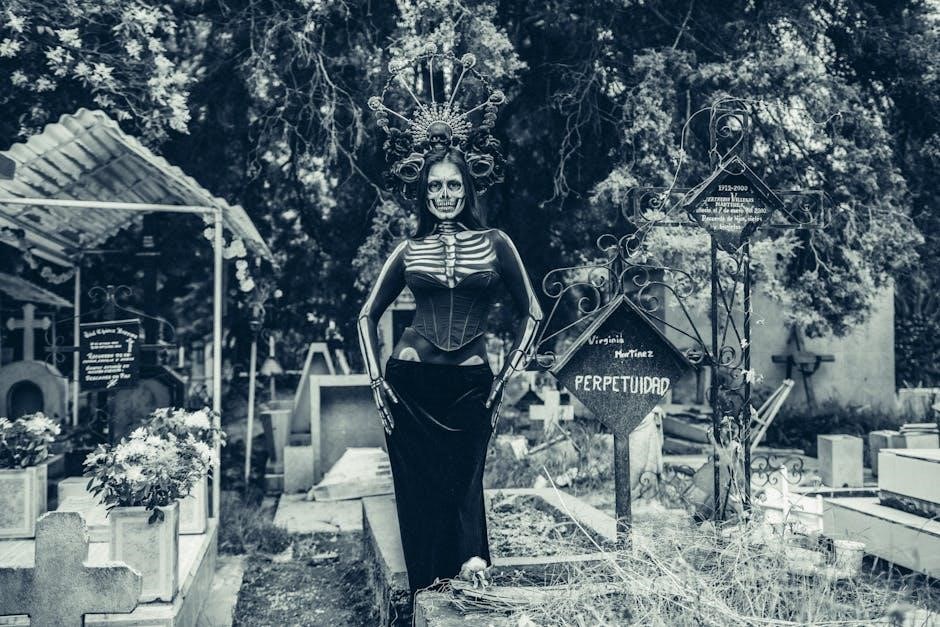
Symbols of the Afterlife and Rebirth
Cemetery symbols like angels, trumpets, and cherubs represent the afterlife and rebirth, signifying resurrection and eternal life. These motifs bring hope and comfort to mourners.
Flying Angel: Rebirth and Resurrection
The flying angel is a powerful symbol of rebirth and resurrection, often depicted with outstretched wings, representing the soul’s ascent to heaven. This motif, common in cemetery art, signifies divine guidance and hope for an afterlife. The angel’s upward flight embodies liberation from earthly bonds, while its serene expression offers comfort to mourners. It is a timeless reminder of spiritual renewal and the promise of eternal life, bridging the earthly and heavenly realms.
Trumpeting Angel: Call to the Resurrection
The trumpeting angel symbolizes the call to resurrection, often depicted sounding a trumpet to announce the Second Coming. This imagery, rooted in Christian theology, signifies the divine summons to eternal life. The trumpet represents judgment and awakening, while the angel embodies hope and renewal. Such symbols comfort mourners by reinforcing beliefs in an afterlife, offering solace through the promise of spiritual rebirth and eternal existence.
Winged Cherubs: Innocence and Spirit of Children
Winged cherubs symbolize the innocence and pure spirit of children, often depicted with soft features and delicate wings. These figures are commonly found on child graves, representing the soul’s ascent to heaven. Their presence offers comfort to mourners, emphasizing the belief in eternal life and divine protection. Cherubs reflect the gentle nature of youth, serving as a poignant reminder of lost innocence and the enduring memory of a child’s life.
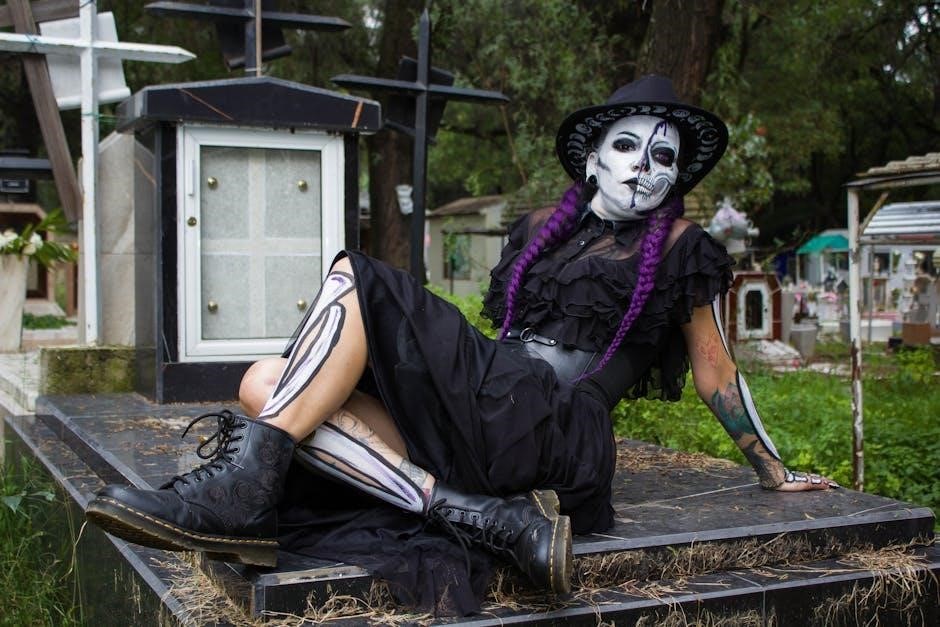
Symbols of Hope and Faith
Cemetery symbols like anchors, crosses, and doves embody hope and faith, offering solace to mourners. They represent eternal trust in divine guidance and spiritual renewal.
Anchor: Hope and Steadfastness
The anchor is a powerful symbol of hope and steadfastness, often found in cemeteries to inspire faith in eternal guidance. Rooted in maritime traditions, it signifies stability amidst life’s storms. In Christian contexts, the anchor represents hope in God’s promises, as referenced in Hebrews 6:19. Cemetery anchors often feature ropes, emphasizing unwavering commitment and trust. This symbol comforts mourners, reminding them of divine reassurance and the enduring hope of eternal life beyond earthly challenges.
Cross: Faith and Religious Devotion
The cross is a universal symbol of Christian faith, commonly found in cemeteries to express devotion and spirituality. It represents the crucifixion of Jesus Christ and the promise of resurrection. Often adorned with intricate designs, the cross serves as a grave marker, symbolizing hope in eternal life. Its presence comforts mourners, reaffirming beliefs in divine redemption and the enduring power of faith. The cross is a timeless emblem of religious devotion and spiritual guidance.
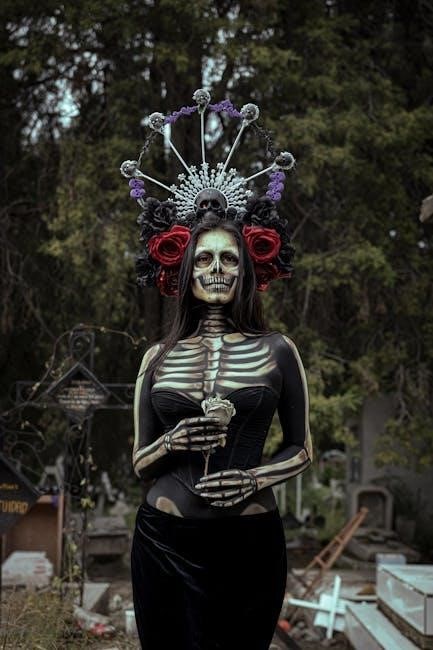
Dove: Peace and Holy Spirit
The dove is a revered cemetery symbol, representing peace, hope, and the Holy Spirit. Often depicted descending from heaven or holding an olive branch, it signifies divine comfort and reconciliation. In Christian tradition, the dove embodies the Spirit of God, offering solace to the grieving. Its presence on gravestones reflects a belief in eternal life and spiritual guidance, reminding mourners of divine love and the promise of peace in the afterlife. The dove’s gentle imagery brings consolation to those remembering loved ones.
Symbols of Love and Devotion
Symbols of love and devotion honor the bond between loved ones, celebrating enduring affection and commitment. They offer comfort, reflecting the deep connections that transcend mortality, celebrating lasting unity and cherished memories in eternal rest.
Heart: Love and Devotion
The heart is a universal symbol of love and devotion, often carved on headstones to represent enduring affection. It signifies the deep bond between souls, transcending mortality. In cemeteries, hearts may be adorned with flowers or ribbons, emphasizing eternal love. This motif comforts mourners, celebrating cherished memories and the soul’s journey. The heart’s presence reminds us of the lasting unity shared between loved ones, even in death.
Hand Clasping a Heart: Charity and Love
A hand clasping a heart is a poignant cemetery symbol representing selfless charity and enduring love. It often honors individuals known for their kindness and generosity. The heart, a timeless emblem of affection, is cradled by the hand, signifying compassion and devotion. This motif consoles mourners, reflecting the deceased’s impact through acts of love and charity. It serves as a lasting tribute to their legacy of kindness and unwavering care.
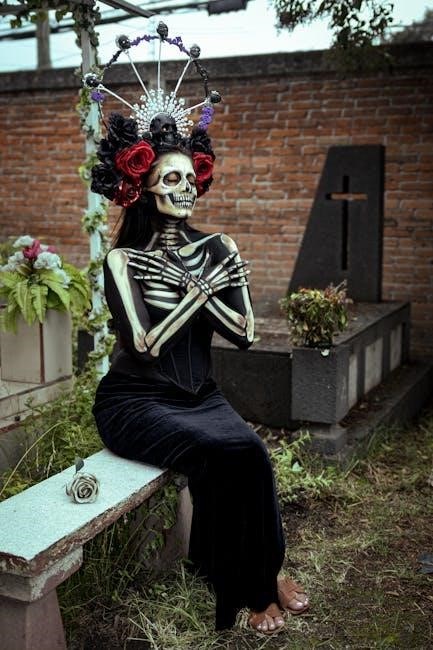
Symbols of Nature and Eternal Life
Nature symbols like trees, flowers, and wheat often represent eternal life and renewal. They evoke feelings of hope and continuity, celebrating life’s enduring spirit.
Tree: Eternal Life and Family Ties
The tree is a powerful symbol of eternal life, strength, and enduring family bonds. Its roots and trunk represent stability, while branches signify growth and aspirations. Often, trees are carved with names or dates, linking generations. They embody resilience, flourishing through seasons, much like the human spirit. In cemeteries, trees evoke hope and continuity, reminding mourners of life’s cyclical nature and the lasting legacies of loved ones. Their presence offers comfort, bridging the past and future.
Palm Frond: Victory and Immortality
The palm frond is a timeless symbol of triumph and eternal life, often seen in cemetery art. Rooted in ancient and religious traditions, it represents victory over death and immortality. In Christian symbolism, it signifies Christ’s triumphal entry into Jerusalem, while in Greek culture, it honored athletes and heroes. On graves, palm fronds denote the deceased’s spiritual victory, offering solace to mourners by emphasizing the soul’s enduring journey and eternal rest.
Wheat: Fully Lived Life
Wheat in cemetery symbolism represents a life well-lived, abundance, and the harvest of one’s efforts. It often signifies a fruitful existence, hard work, and maturity. Commonly used on headstones, wheat imagery reflects a life that has reached full potential, symbolizing the cycle of growth, decay, and renewal. It honors individuals who left a lasting legacy, embodying the rewards of a life dedicated to labor and love, ensuring their memory endures like the golden fields they cultivated.
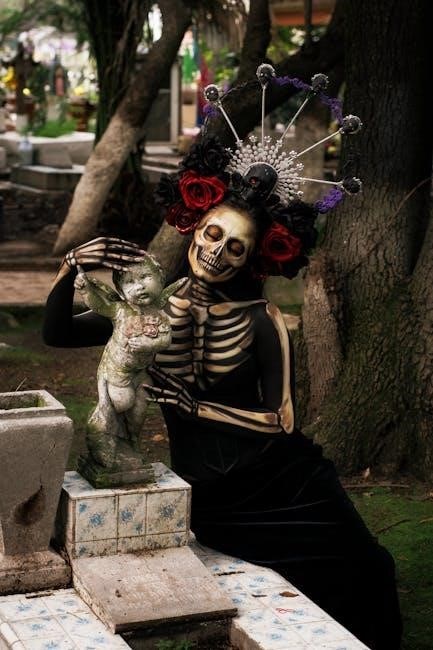
Symbols of Occupation and Fraternal Orders
Cemetery symbols often reflect professions or fraternal memberships, such as tools for workers or Masonic emblems, honoring the deceased’s life work and affiliations with pride and legacy.
Compass and Square: Masonic Symbols
The compass and square are prominent Masonic symbols often found on gravestones, representing balance, order, and moral conduct. The compass signifies wisdom and heavenly guidance, while the square embodies earthly honesty and fairness. Together, they symbolize the harmony between spiritual and practical life. These tools, central to Masonic teachings, honor the deceased’s allegiance to fraternal principles and their pursuit of self-improvement and service to humanity.
Fraternal Emblems: Membership and Beliefs
Fraternal emblems on gravestones signify the deceased’s affiliation with organizations like the Freemasons or Odd Fellows. These symbols, such as the three-linked chain, represent unity and shared values. They reflect the individual’s commitment to fraternity, mutual aid, and specific ethical beliefs. Such emblems serve as silent testimonials to the person’s dedication to their fraternal community and the principles they upheld during their lifetime.
Symbols of Grief and Mourning
Symbols like weeping willows and urns reflect sorrow and bereavement, honoring the deceased while providing solace to the grieving through their enduring, emotive representations.
Weeping Willow: Grief and Mourning
The weeping willow, with its drooping branches, symbolizes profound grief and mourning in cemeteries. Its sorrowful appearance reflects the emotional weight of loss and bereavement. Often placed near graves, it signifies the soul’s journey to the afterlife and provides solace to the grieving. The willow’s enduring presence reminds mourners of eternal life and memory, offering comfort through its natural, quiet beauty and resilience.
Urn: Mourning and Bereavement
The urn is a poignant symbol of mourning and bereavement, often representing the containment of earthly remains. Its presence in cemeteries signifies the transition from life to death, offering a physical vessel for grief. Decorated with willow branches or flowers, it may also evoke eternal life or heavenly rest. The urn serves as a comforting reminder of loved ones, embodying both loss and the enduring memory of those who have passed, bridging the gap between sorrow and solace.
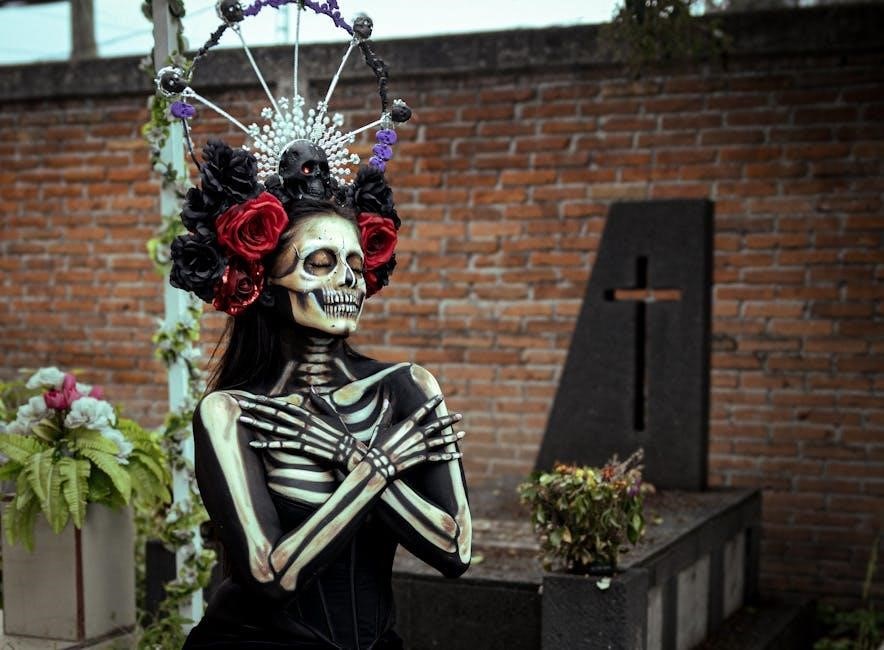
Symbols of Animals and Their Meanings
In cemeteries, animals symbolize human qualities and emotions, reflecting the deceased’s character or the mourner’s grief. Common symbols include lions for strength, doves for peace, and dogs for loyalty, each offering unique insights into the lives and memories of those remembered.
Swallow: Motherhood and Consolation
The swallow is a meaningful cemetery symbol, often representing motherhood, love, and consolation. Its migratory return signifies renewal and the enduring memory of loved ones. In grave markers, swallows are frequently depicted to honor mothers or children, embodying fidelity and the hope of reunification. Their presence conveys comfort to the grieving, symbolizing the soul’s journey and the promise of eternal connection, making them a poignant expression of love and remembrance.
Bird: Eternal Life and Spirit
Birds in cemetery symbolism often represent the soul or spirit, embodying eternal life and transcendence. Their upward flight is seen as a metaphor for the soul ascending to heaven. Doves, in particular, signify peace and divine presence, while other birds may symbolize freedom, hope, or the journey to the afterlife. Their presence in grave art offers comfort, reminding mourners of the enduring essence of life and the promise of spiritual continuation beyond death.
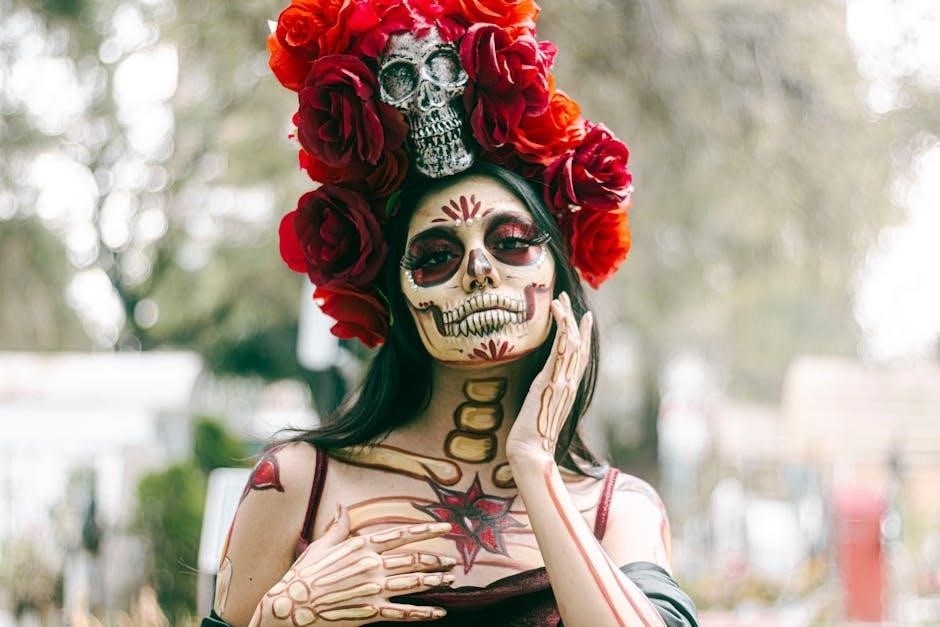
Symbols for Children and Infants
Symbols for children and infants in cemeteries often include lambs, cherubs, and flowers, representing innocence, purity, and the promise of eternal life in heaven.
Sleeping Cherub: Innocence and Youth
A sleeping cherub symbolizes the peaceful rest of a child, embodying innocence and purity. Often depicted with delicate wings and a serene expression, it represents eternal slumber and divine care. This symbol comforts mourners, signifying the child’s spirit is at peace. The cherub’s presence in cemeteries serves as a poignant reminder of the brief yet meaningful life of the child, while also offering solace to the grieving family.
Lamb: Innocence and Purity
The lamb is a timeless symbol of innocence and purity, often used to commemorate children or infants in cemeteries. Its gentle nature and association with Jesus, the “Lamb of God,” convey deep spiritual significance. Depictions of lambs on gravestones signify the child’s untainted soul and their eternal rest in divine care. This imagery brings comfort to mourners, reinforcing the belief in the child’s peaceful transition to a sacred afterlife.
Symbols of Victory and Consolation
Symbols of victory and consolation often represent triumph over adversity and comfort in grief. They embody resilience and hope, guiding mourners toward healing and peace.
Inverted Torch: Life in the Next Realm
The inverted torch symbolizes the transition from earthly life to the afterlife, representing the soul’s journey to the next realm. It signifies the end of mortal existence and the beginning of eternal life, offering comfort and hope to mourners. This symbol is often associated with guiding the deceased to the spiritual world, embodying resilience and the continuation of life beyond death. It serves as a powerful reminder of life’s eternal nature and the solace found in belief.
Palm Frond: Victory and Comfort
The palm frond is a symbol of triumph and solace, often used to honor the deceased. It signifies victory over death and eternal life, drawing from biblical imagery where palms represent celestial joy. In cemeteries, it offers comfort to grieving families, embodying the hope of heavenly peace. The palm frond also reflects resilience and divine triumph, serving as a reminder of eternal rest and spiritual victory. Its presence brings solace and reassurance of a life well-lived and celebrated.
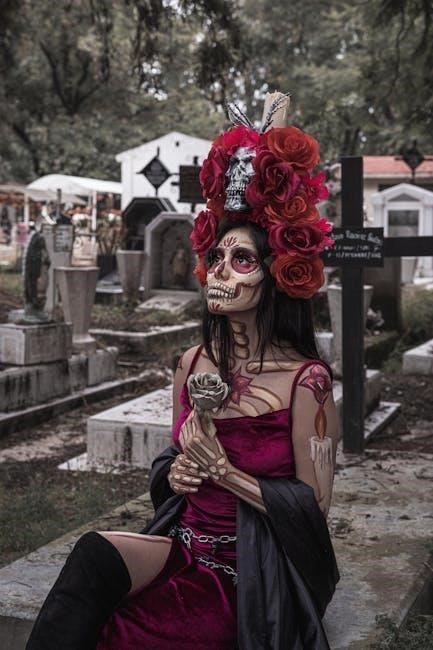
Symbols of Eternal Life
Symbols of eternal life in cemeteries represent enduring strength and unity, such as trees and circles, signifying continuous life and heavenly connection beyond death.
Tree: Strength and Endurance
The tree is a universal symbol of eternal life, strength, and endurance. In cemeteries, it often represents the connection between heaven and earth, signifying immortality and resilience. Evergreen trees, in particular, embody perpetual life, as they remain vibrant year-round. Carvings of trees on headstones may depict roots for stability and branches for growth, emphasizing the deceased’s enduring legacy. This imagery offers comfort, reminding mourners of life’s continuity and the soul’s journey beyond death.
Circle: Eternity and Unity
The circle is a timeless symbol of eternity and unity, often found in cemetery art. Representing infinity and wholeness, it signifies life without end and the unbroken bond between the living and the deceased. Grave markers featuring circles, such as rings or wreaths, emphasize eternal love and the cyclical nature of life. This symbol also reflects unity, whether in family ties, marital bonds, or spiritual connection, offering solace to those grieving by reminding them of enduring relationships and the promise of eternal life.
